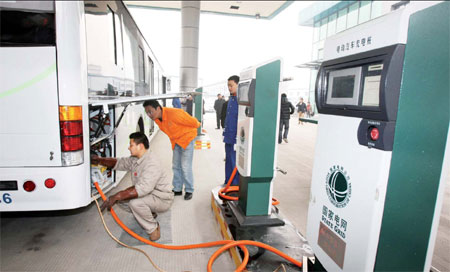Through the smog an opportunity
Spare parts makers stand by for electric and hybrid cars to become more common
It should be the season of clear air in most cities in North China, but things seem to be changing: dreadful smog that once blanketed the skies predominantly in winter is now appearing in autumn.
And as that smog appears, there is understandable public griping, including the inevitable search for a culprit. One of those at the head of the line is the car industry. But instead of gently accepting such criticism, companies and policymakers peering through the thick smog have spotted an opportunity: introducing alternative vehicles to the market.
While electric vehicles in varying assortments, including hybrid cars and buses, are doing their bit for the environment, they are still vastly outnumbered on China's roads by combustion-engine cars.
But European and Japanese car makers seem to be well-prepared for a transport revolution in China. Dong Yang, vice-secretary-general of the China Association of Automobile Manufacturers, says Volkswagen has told him it has incorporated electric-vehicle spare parts into its regular production lines, so that once the market needs the products in large volumes, it can rapidly put at least 40 models on the market. The company now has two fully developed electric cars and two plug-in hybrid cars.
The German parts maker Bosch has also prepared new-technology stock for models other than combustion vehicles, Dong says.
"The Chinese market is vital for European and Japanese automakers, and it seems they won't miss the opportunity to roll out new-energy lines once the opportunity is there, so they are already ahead of their Chinese competitors in this new round of competition."
The domestic brands need to speed up their research and development so they do not lose the market in the next 10 years, Dong says.
European standards are usually a reference point for Chinese policymakers, and in Britain the Liberal Democrats, part of the ruling coalition, recently proposed that all petrol or diesel-powered vehicles should be outlawed by 2040.
In California, a leader in environmental protection measures, the government has various policies to encourage alternative vehicles. For example, during the rush hour in cities, traditional cars with fewer than two passengers are banned from the roads, a rule not applied to hybrid cars.
These practices may be adopted by the Chinese policymakers in the future, experts say.
The country's leadership is also sending out clear signals that it is resolute in addressing the problem of pollution, often linked with traffic congestion, because when a car is idling it emits more toxic gases than when it is traveling at speed.
The government recently set out a series of policies, including incentives and penalties, to discourage the use of combustion cars and reduce pollution. As it has raised fuel efficiency levels much higher for car makers, it has introduced new subsidies for low-emission and hybrid cars.
Regulations for new-energy cars that came into force on Oct 1 require car makers eligible for subsidies to reduce the average gasoline consumption per 100 kilometers from 6.6 to 5.9 liters, and the Beijing government is discussing legislation to cap the number of cars in Beijing at 6 million or 7 million. There is also speculation that the number of licenses issued will be halved from next month.
Almost 1.6 million people in Beijing are in line to go into a ballot for a car license, and many potential motorists are now opting for electric vehicles as a way of circumventing that process.
Electric bus makers such as Foton, King Long and Yutong are already reaping the benefits. Since 2008, Foton has delivered nearly 10,000 new-energy buses across the country, and Yutong has received orders for more than 1,000 units during the second quarter.
Wu Wei, of the industry coordination division of the National Development and Reform Commission, says local governments have bought more than 5,000 electric buses since last year and achieved good results in cutting emissions. "So before 2015, the government will still offer subsidies for electric buses, but will gradually cut the amounts granted, so these alternative means of transport can learn to survive in the market."
Meanwhile, the makers of hybrid cars are stepping up their government lobbying and advertising. Their big selling points are lower fuel consumption and exhaust emissions, as well as better reliability compared with pure electric cars.
Hybrid cars come in three categories - micro hybrid, mild hybrid, and strong hybrid - based on how much fuel they save.
"The hybrid is indispensable before we enter the electric vehicle era," says Shinichi Matsumoto, head of the research and development center of Toyota China.
Toyota has set up a research and development center in Changshu, Jiangsu province, to work on spare parts for hybrid models, with domestic partners such as FAW.
"At the beginning when we launched hybrid models in Japan, the public response was very tepid, but thanks to government subsidies, customers have gradually accepted it, and now it is the world's top hybrid model," Matsumoto says.
Zhao Fuquan, director of Tsinghua University research center for automotive industry and technology innovation, says being environmentally friendly is not a selling point for many car makers, as the public is still not that environmentally conscious, but if a car saves petrol, customers will buy it.
"When selling lower-emission cars, the dealers need to bear that in mind and adjust strategies accordingly. But if there are to be more hybrid cars on the road, we need more than automakers. We also need to cultivate a group of spare parts companies so an industry value chain is formed."
|
Amid the serious smog in northern Chinese cities, government policies to curb the number of combustion engine cars create business opportunities for electric and hybrid vehicles. Provided to China Daily |



















